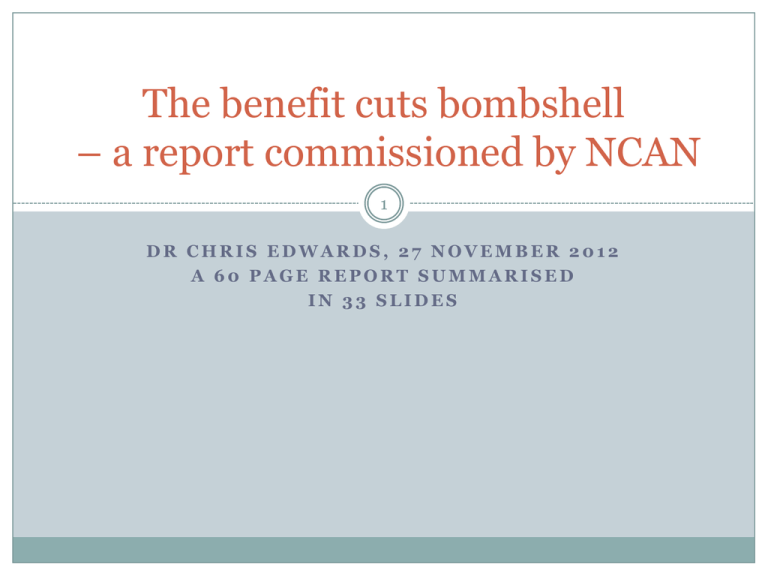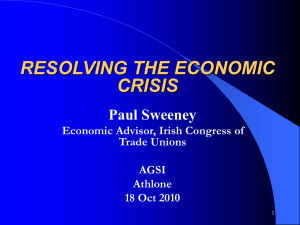the Powerpoint presentation by Dr Chris Edwards
advertisement

The benefit cuts bombshell – a report commissioned by NCAN 1 DR CHRIS EDWARDS, 27 NOVEMBER 2012 A 60 PAGE REPORT SUMMARISED IN 33 SLIDES The context of the cuts 2 The financial crisis of 2007-08; caused by the incompetent regulation of the banks; …. followed by…. The General Election of May 2010 and the emergence of the Coalition Government Coalition Agreement; “deficit reduction is the most urgent issue facing Britain” The Austerity Package 3 The Budget and Spending Review of 2010 announce cuts in government spending and increases in taxes amounting to £79 billion by 2014-15, consisting of… 1. £10 billion from savings in interest on debt; 2. £3 billion from increases in taxes; 3. £18 billion from cuts in benefits; and, 4. £48 billion from cuts in other government spending What this report looks at 4 The cuts in benefits administered by the tax office (child benefit and tax credits) and by the DWP The base year of the study is 2010-11 when these benefits totalled £191 billion or just over half of all social expenditure (£353 billion) in the UK Most of the difference of £162 billion consists of expenditure on health (£121 billion) and personal social services (£32 billion) £191 billion is 13% of GDP The cuts in benefits 5 The cuts in benefits looked at here total £15.6 billion after taking off the cuts in public service pensions (which are excluded) The cut of £15.6 billion in 2014-15 is 8% of the total benefits in 2010-11 Over the four years, the cuts amount to £36.3 billion or 19% of the £191 billion Timeline of main changes Migration fro IB to ESA Migration from DLA to PIP Housing Benefit Changes Social Fund to County Council Universal Credit Implementation Total Benefit Cap Local Council Tax Rebate … 2012 2013 2014 2015 2016 … The timing of the benefit cuts 7 Timing of the cuts in benefits - 2011-12 to 2014-15 Year 2011-12 2012-13 2013-14 2014-15 Total over the four years ----------------Cuts ---------------------(£ billion) % of 4 % of benefits year total in 2010-11 1.8 5 0.9 6.4 18 3.4 12.5 34 6.5 15.6 43 8.2 36.3 100 19.0 The composition of the benefit cuts 8 Cuts in benefits in 2014-15 - composition Benefits Disabled people Pensions, pension credits and winter fuel allowance Council tax benefits Housing benefit Child benefit Tax credits Others Total Total in Cuts in 2014-15-------2010-11 % of the (£ billion) (£ billion) total 32 4.4 14 81 5 21 12 28 12 191 -0.5 0.4 2.3 3.5 3.6 1.9 15.6 -1 8 11 29 13 16 8 The major cuts – disabled people 9 Total in 2010-11 = £32 billion Cut in 2014-15 as a percentage of 2010-11 = 14% How? Switch to CPI from RPI for uprating benefits 2. A reassessment of IB and switch to ESA using the WCA 3. A new PIP to replace the current DLA from April 2013 for people of working age 1. No cuts – the elderly 10 Total in 2010-11 = £81 billion Increase in benefits in 2014-15 of 0.6% How? Uprating of pensions by best of CPI, RPI and earnings (the triple guarantee) - gain to pensioners of £500 million in 2014-15 2. No net change in pension credit and winter fuel payments combined (changes but they cancel each other out) 1. Council tax benefits (1 of 2).… 11 Total in 2010-11 of £5 billion Cut in 2014-15 of 8% How? In April 2013, Local Authorities will have to implement their own schemes of Council Tax Support (CTS) to replace Council Tax Benefit (CTB) 2. In doing so, the LAs will face a cut of 10% (very recently changed to 8%) of the unreformed CTB. 1. … but little localism (2 of 2) 12 LAs cannot reduce pensioners’ benefits so the whole adjustment falls on those of working age or other Council expenditure; Council tax has been frozen for 2010-11 and will be frozen through 2013-14 (for the fourth year) Post-code lottery; possibly back to something like a poll tax (with small CT charges) and a resulting rise in administrative costs for Councils. Housing Benefit 13 Total of £21 billion in 2010-11 Cut in benefits in 2014-15 of £2.3 billion (11%) How? (8 major changes) Child Benefit 14 Total in 2010-11 = £12 billion Cut of 29% or £3.5 billion in 2014-15 How? Freezing of child benefit for 3 years from 2011-12 (£1.0 billion) 2. Taxing away of child benefits for higher rate taxpayers from January 2013 (£2.5 billion) 1. Tax credits 15 Total of £28 billion in 2010-11 Cut of 14% or £3.6 billion How? £2.2 billion net cuts announced in June Budget of 2010, plus … 2. .. further net cuts announced in the Spending Review of 2010 of £1.1 billion plus …. 3. ..a further cut of £0.3 billion announced in the Autumn Statement of 2011 1. Other benefits 16 Total in 2010-11 = £12 billion (including Income Support for lone parents and carers (£2.9 bn), JSA (£4.5 bn), Maternity Pay (£2.4 bn) and others £2.2 bn. Cut, including a halving of the Social Fund (to be decentralised to the County Council but not ringfenced), averages 16% in 2014-15 The Universal Credit (1 of 3) 17 First claims under the Universal Credit in October 2013 leading to all claimants being included by the end of 2017 What is the UC? 1. A radical reform integrating six core benefits (income-related JSA, income-related ESA, income support child tax credit, working tax credit and housing benefit) into one monthly payment paid to a single recipient 2. Child benefit and Council Tax Benefit (Support) will remain separate. The Universal Credit (2 of 3) 18 Claimed advantages Improvement of work incentives – “yes for single earners, but not for working couples and even for single earners, the picture is confused by CTB being outside” (IFS); and are the jobs available? 2. Simplification and reduced administrative costs – but will the IT system work? Probably not, says Frank Field (and many other doubters); call for delay (Work and Pensions Select Committee, 22 November 2012) 1. Universal Credit (3 or 3) 19 Other advantages of UC? Will reduce the total of unclaimed benefits (IFS) – but doubtful if the Treasury sees it this way since unclaimed benefits total between £15 bn and £21 bn. compared to losses from fraud and official errors of about £2 bn; 2. Some gains, some losses to different groups according to the IFS but net effect ignored here because net gains unlikely to be realised by 201415. 1. The equalising role of benefits 20 Source; ONS (ETB) for 2010-11 Households Disposable Percentage of disposable income in … income (£000) … benefits … taxes Poorest fifth 10.8 65 -43 Richest fifth 63.9 3 -44 All households 30.3 18 -41 The distribution of benefits and cuts in benefits 21 The distribution of benefits and cuts in benefits Quintile 1 (poorest) 2 3 4 5 (richest) All Percentage of Cuts in benefits benefits in in 2014-15 2010-11 (£ billion) 26 4.1 30 4.1 23 3.3 14 2.4 7 1.7 100 15.6 The poorest lose out 22 The poorest 40% of UK households have an average disposable income of £14,250 a year In 2014-15 their loss from the cuts in benefits will be £8.2 billion. This is £780 per household or about £15 per week. Over the four years, the loss for this same 10.5 million households will average £8.65 per week The situation in Norfolk? 23 Norfolk is a County with a lower average income – about 10-15% lower - than for the UK as a whole …. … but it is not a County of great deprivation. In England there are a little over 3,000 LSOAs (Lower Super Output Areas or LSOAs) which are the 10% most deprived in England. Of Norfolk’s 530 LSOAs, 29 are among these most deprived. All except one of these are in three of the seven Districts of Norfolk (Great Yarmouth, KLWN and Norwich) 24 Norfolk – the benefit cuts? In total 25 Total benefits to Norfolk in 2010-11 = £2.7 billion (1.4% of the total for about 1.4% of the UK population) The cuts in benefits for Norfolk in 2014-15 = £181 million or about 7% of total benefits. Loss of £9.36 per household per week The cuts in benefits over the four years will total about £421 million or £1,132 per household Norfolk – the benefit cuts? By Local Authority 26 Cuts in benefits in the seven LAs in Norfolk in 2014-15 Total benefits in 2010-11 Cut in Number of Cut in benefits in households benefits in 2014-15 2014-15 (£m) (£m) (000) (£ phpw) Breckland 397 26 55 9.09 Broadland 349 21 53 7.62 Great Yarmouth 354 27 42 12.36 KLWN 484 32 63 9.77 North Norfolk 358 19 46 7.94 Norwich 411 35 60 11.22 South Norfolk 344 22 53 7.98 Norfolk 2696 182 372 9.41 Note; the last column is the cuts in benefits per household per week Norfolk – the benefit cuts? By income? 27 Unfortunately there is no reliable income distribution data for Norfolk But we do know that 19% of households in Norfolk live in poverty – that is below 60% of the median income – which means below £10,000 per year 19% = 70,000 of the 372,000 households in Norfolk Norfolk – the benefit cuts? For households in poverty 28 In 2014-15, these 70,000 poverty-stricken households will lose £15 per week or about 8.7% of their income in the base year (2010-11) Over the four years, these 70,000 povertystricken households will lose an average of £8.65 per week – yes, over the four years. The cuts are clearly not fair… are they efficient? 29 The answer is no. The government is not achieving its objective of cutting the deficit In the first 7 months of this tax year (2012-13), net borrowing by the public sector was £5.0 billion up on the same period of last year (ONS, November 2012). At a time when households are cutting expenditure to cut their personal debt - when the USA and the Eurozone is growing slowly, if at all - this is when the UK government chooses to cut its expenditure. Implications for advice agencies? 30 Stark prospects 1. Poverty increasing; increase in demand for Norwich Foodbank; homelessness up by 9% (Shelter); a rise in demand for high interest credit; vulnerable not protected (a NEF November report); rise in number of children going without food (Action for Children); 2. Demand for advice services already up (CAB in Haringey – increase of 200% in demand for advice in two years). 3. And yet the cuts in benefits have hardly started - more madness is yet to come with 77% of the cuts in benefits due in the next two tax years - that is, April 2013 to April 2015 Need for more equality not less 31 A prize for the first person to guess who said the following; “Research by Richard Wilkinson and Katie Pickett has shown that among the richest countries, it’s the more unequal ones that do worse according to almost every quality indicator. In ‘The Spirit Level’ they show that per capita GDP is much less significant for a country’s life expectancy, crime levels, literacy and health than the size of the gap between the richest and poorest in the population. So the best indicator of a country’s rank on these measures is not the difference in wealth between them, but the difference in wealth within them” So the more equal a country is, the better off it is. By this criterion, the cuts are bound to be counter-productive.






